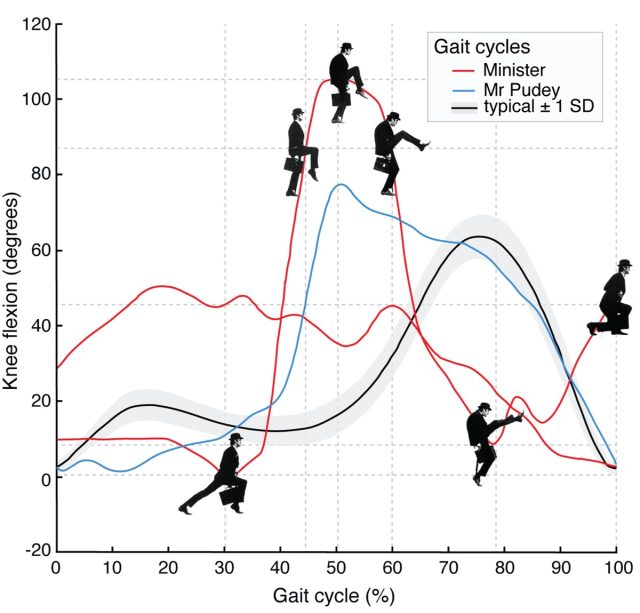One of the best-known sketches from Monty Python's Flying Circus features John Cleese as a bowler-hatted bureaucrat with the fictional Ministry of Silly Walks. It's a classic of physical comedy, right up there with the troupe's Dead Parrot sketch ("This parrot has ceased to be!") in terms of cultural significance.
A pair of scientists at Dartmouth University have performed a gait analysis of the various silly walks on display, publishing their findings in a new paper in the journal Gait and Posture. It's intended in part as a commemoration on the 50-year anniversary of the sketch, but also to draw attention to the need for a more streamlined peer review process for grants in the health sciences.
The two authors, Erin Butler and Nathaniel Dominy, are married, having met 12 years ago at Stanford. (Butler was a TA for a class where Dominy gave a lecture on the evolution of bipedalism.) Dominy is the Monty Python fan. "So, put together a Monty Python fan with a creative scientific mind and an expert in gait analysis, and this paper is what you get," Butler told Ars. Or, as they wrote in their paper, "It really is the silliness of the sketch that resonates with us, and extreme silliness seems more relevant now than ever before in this increasingly Pythonesque world."
First aired on September 15, 1970, on BBC One, the sketch opens with Cleese's character buying a newspaper on his way to work—which takes him a bit longer than usual since his walk "has become rather sillier recently." Waiting for him in his office is a gentleman named Mr. Putey (Michael Palin) seeking a grant from the Ministry to develop his own silly walk. (Note: the name is spelled "Pudey" in the paper but we're going with the Wiki spelling.) Mr. Putey demonstrates his silly walk-in-progress, but the Minister isn't immediately impressed. "It's not particularly silly, is it?" he says. "I mean, the right leg isn't silly at all and the left leg merely does a forward aerial half turn every alternate step."
Mr. Putey insists that a government grant would allow him to make the walk very silly indeed. The Minister proceeds to talk about budgetary constraints—all while walking in a silly manner around his the office—and shows him an old film reel of various silly walks. Finally, he informs Mr. Putey that he would like to offer him a research fellowship on the Anglo-French silly walk. The sketch cuts to a pair of Frenchmen demonstrating this "La Marche Futile."

This isn't the first time scientists have thought to study the unusual gaits depicted in the sketch, with an eye toward applying the biomechanical lessons learned to designing better robots, for instance. Back in 2007, researchers at Cornell University concluded that, while entertaining, the silly walks required far more energy expenditure than conventional walking and running. (This might partly explain why Cleese in later years declined to perform the silly walks, since the movements became increasingly difficult for him.)
For their own gait analysis, Butler and Dominy studied both Mr. Putey's and the Minister's gait cycles in the video of the original 1970 televised sketch, as well as the Minister's gaits from a 1980 live stage performance in Los Angeles. "If silly walking can be defined as deviations from typical walking, then silliness can be quantified using two-dimensional video-based motion analysis," they wrote. So that's what they did. Butler and Dominy found that the Minister's silly walk isRead More – Source
[contf] [contfnew] 
arstechnica
[contfnewc] [contfnewc]






![NASAs most complex, ambitious rover yet is on its way to Mars [Updated]](https://amsterdamtimes.info/wp-content/uploads/2020/07/PIA23154_large-980x653-1-300x160.jpg)